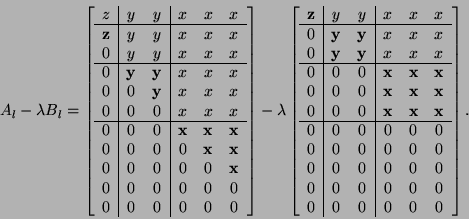For completeness, we consider a pencil ![]() with all different types
of structure blocks in its KCF:
with all different types
of structure blocks in its KCF:


Since these forms are computed using the ![]() -staircase reduction,
the block indices
-staircase reduction,
the block indices ![]() and
and ![]() start to count from the southeast corner.
Now, superdiagonal blocks of
start to count from the southeast corner.
Now, superdiagonal blocks of ![]() and
and ![]() have full row rank
and diagonal blocks of
have full row rank
and diagonal blocks of ![]() and
and ![]() have full column rank.
In the following table, the structure indices for the
have full column rank.
In the following table, the structure indices for the
![]() -,
-, ![]() -, and
-, and ![]() -staircase forms are summarized.
-staircase forms are summarized.
|
|
|

So far the description for computing the GUPTRI form has relied on infinite precision arithmetic. In the presence of roundoff the problem is regularized by allowing a deflation criterion for range/null space separations and thereby makes it possible to compute the GUPTRI form of a nearby matrix pencil.
This GUPTRI form is computed by a sequence of unitary equivalence transformations. The equivalence transformations are built from rank-revealing factorizations used to find orthonormal bases for different null spaces associated with the matrix pair.